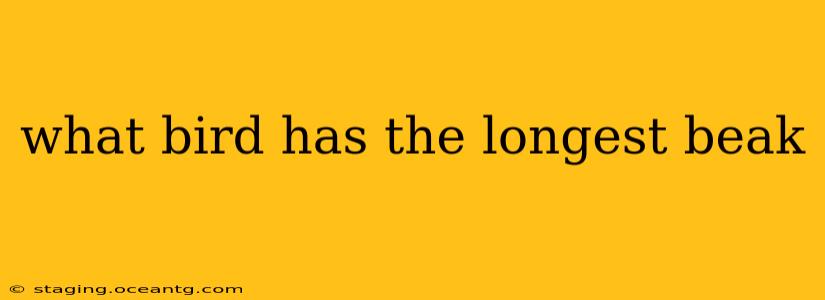The title itself hints at a straightforward answer, but the reality is more nuanced than simply naming a single species. The "longest beak" depends on how you define "longest"—are we talking about absolute length, beak length relative to body size, or perhaps even beak length adjusted for different beak shapes? This exploration delves into the fascinating world of avian beaks and identifies some strong contenders for the title of "longest beak."
Which Bird Has the Longest Beak in Absolute Terms?
Several species vie for the top spot in terms of sheer beak length. One of the most prominent candidates is the Sword-billed Hummingbird ( Ensifera ensifera). Its beak is truly remarkable, often exceeding the length of its body. The extraordinarily long, slender beak is perfectly adapted for reaching the nectar deep within the long, tubular flowers it feeds on in the cloud forests of the Andes Mountains. While other species might have slightly longer beaks in certain instances (due to individual variation), the Sword-billed Hummingbird consistently demonstrates impressive beak length.
What About Beak Length Relative to Body Size?
While the Sword-billed Hummingbird boasts a long beak, its relative beak length might not be the most extreme. Consider the Ocellated Antbird (Phaenostictus mcleannani). This relatively small bird has a beak that is exceptionally long compared to its body size. This adaptation is crucial for its specialized foraging strategy, allowing it to probe deep into crevices and beneath leaf litter to find insects. The precise measurement for the relative beak length to body size is challenging, as it varies across individuals and species.
Are There Other Birds with Notably Long Beaks?
Beyond these two prominent examples, numerous other bird species possess remarkably long beaks, each adapted to their unique ecological niche:
- Kirtland's Warbler (Setophaga kirtlandii): This endangered warbler has a relatively long beak, beneficial for foraging in the undergrowth.
- Avocets (Recurvirostridae family): These wading birds have long, upturned beaks perfectly designed for sifting through shallow water in search of small crustaceans and insects.
- Shoebills (Balaeniceps rex): While not strictly the longest, the massive, shoe-shaped beak of the Shoebill is undeniably striking and well-suited to its diet of lungfish and other aquatic prey.
What Determines a Bird's Beak Length?
A bird's beak length is a crucial adaptation shaped by evolutionary pressures. The length, shape, and size of a bird's beak are directly linked to its diet and foraging behavior. Birds that feed on nectar from deep flowers tend to have longer beaks, whereas those that eat seeds or insects may have shorter, stronger beaks. This close relationship between beak morphology and ecological niche demonstrates the power of natural selection.
How is Beak Length Measured?
Accurately measuring beak length requires careful methodology. Researchers generally measure from the tip of the upper mandible to the base of the beak at the skull. However, consistent and reliable measurements across different species and individual birds can be challenging due to variations in beak shape and curvature.
What are the functions of a bird's beak?
Bird beaks serve many crucial functions beyond just feeding. They are used for:
- Preening: Cleaning and maintaining feathers.
- Nesting: Building nests and caring for eggs and young.
- Defense: Protecting themselves from predators.
- Courtship displays: Attracting mates.
- Probing: Exploring environments for food.
In conclusion, while pinpointing one single bird with the absolute longest beak is difficult due to variations and measurement challenges, the Sword-billed Hummingbird and Ocellated Antbird represent excellent examples of avian species with exceptionally long beaks, each perfectly adapted to their unique ecological roles. The diversity of beak lengths and shapes across bird species underscores the fascinating interplay between adaptation and natural selection.
